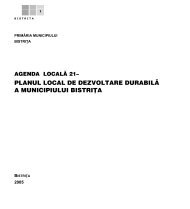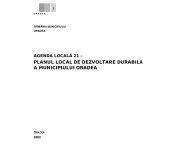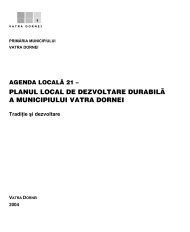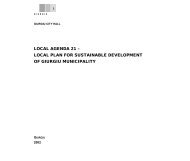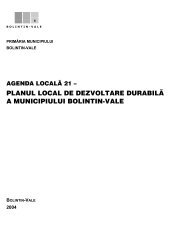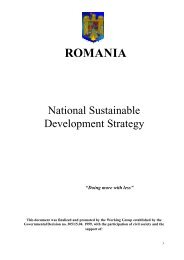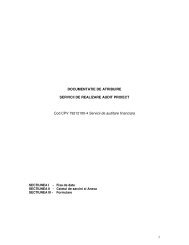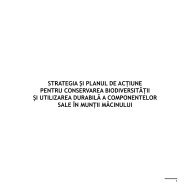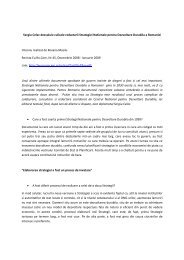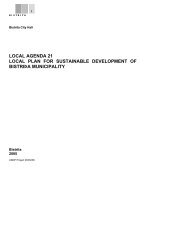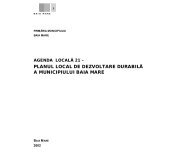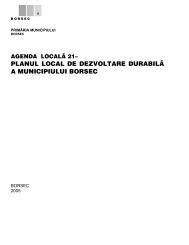Local Plan for Sustainable Development of Sibiu Municipality
Local Plan for Sustainable Development of Sibiu Municipality
Local Plan for Sustainable Development of Sibiu Municipality
Create successful ePaper yourself
Turn your PDF publications into a flip-book with our unique Google optimized e-Paper software.
14<br />
MUNICIPALITY<br />
main river is the Cibin River, which receives two<br />
tributary streams on the territory <strong>of</strong> the city; from the<br />
right side, the Trinkbach brook and the Valea<br />
Săpunului, and two tributary streams from the left side,<br />
the Fărmândoala and Rusciorului brooks.<br />
On the Cibin River, upstream from the Gura Râului<br />
village, a concrete retention dam was built during<br />
1973-1980. It had the role <strong>of</strong> supplying the<br />
municipality <strong>of</strong> <strong>Sibiu</strong> and the adjacent cities with water<br />
and energy, as well as diminishing the <strong>for</strong>ce <strong>of</strong> the<br />
flood wave during flood time.<br />
There are 4 dams on the Trinkbach brook, <strong>for</strong><br />
recreational purposes and <strong>for</strong> flow regularization.<br />
To the east, the city is bordered by Valea Săpunului, a<br />
channel leaving from the Şteaza brook (Răşinari<br />
zone), which carries a controlled water flow and which<br />
can be used <strong>for</strong> diverse purposes.<br />
An important role <strong>for</strong> the flora in Sub Arini Park is a<br />
controlled channel that leaves from the Village<br />
Museum, and supplies the underground water stream<br />
– the trees reservoir on the left side <strong>of</strong> the park.<br />
The quality <strong>of</strong> the underground water layer is<br />
monitored by two drillings, <strong>for</strong> which regular analyses<br />
are carried out. Since in recent years there has been<br />
no periodic pumping <strong>of</strong> the water in the drilling holes,<br />
analysis results are not reliable in investigating the<br />
pollution levels <strong>of</strong> the phreatic layer. Presently, the<br />
water from the underground layer is used in low<br />
quantities in industry or as drinking water.<br />
The Cibin River has an annual average flow <strong>of</strong> 2.8<br />
cubic meters per second under a managed regime.<br />
From the water quality point <strong>of</strong> view, the Cibin River<br />
has the 2 nd quality category at the entrance in the city,<br />
and passes to the 3 rd quality category downstream <strong>of</strong><br />
the city, because <strong>of</strong> the partially treated effluents. The<br />
flow degrades itself after the Mohu treatment plant, 10<br />
km downstream from <strong>Sibiu</strong>.<br />
Water – supply sources<br />
Water supply <strong>for</strong> <strong>Sibiu</strong> was provided from sources that<br />
depended on the socio-economic development <strong>of</strong> the<br />
city. The first water source was built downstream from<br />
Răşinari, from Ştezii waterside, which later was<br />
completed with supplies from water streams in Păltiniş.<br />
After 1975, the flow from the available sources<br />
became insufficient, so a new supply source had to be<br />
identified. This was the Cibin River, upstream from<br />
Gura Râului. Thus, the concrete dam was built, as a<br />
permanent reservoir, 25 km upstream from <strong>Sibiu</strong>, with<br />
a volume <strong>of</strong> 15.5 million cubic meters <strong>of</strong> water, which<br />
can supply <strong>Sibiu</strong> and the adjacent cities with a volume<br />
<strong>of</strong> about 50 million cubic meters per year.<br />
The analysed water meets the quality requirements <strong>for</strong><br />
processing into drinking water and it is a reliable water<br />
source <strong>for</strong> <strong>Sibiu</strong> and the adjacent cities. The untreated<br />
water is transported through two pipelines <strong>of</strong> Ø 1 000<br />
and Ø 600 to the Poplaca treatment plant and from<br />
there, it is gravitationally transported to consumers.<br />
The Sadu River is considered a supplementary source<br />
<strong>for</strong> water supply; <strong>for</strong> this reason, a pipe system and a<br />
supply were built here. A new accumulation on one <strong>of</strong><br />
the streams tributary to Olt River can be considered to<br />
be a future source.<br />
Water – aggressive element<br />
Until the building <strong>of</strong> the reservoir on the Cibin River,<br />
<strong>Sibiu</strong> was <strong>of</strong>ten flooded, even if some <strong>of</strong> the districts<br />
had dams.<br />
There are reservoirs on the Trinkbach brook, which<br />
take the big flows from its hydrographic basin and<br />
discharge them downstream, in a controlled manner.<br />
The flooding <strong>of</strong> properties in the vicinity <strong>of</strong> the<br />
Trinkbach brook course is sometimes caused by not<br />
using the reservoirs at projected parameters.<br />
Summing up, the surface water can not flood <strong>Sibiu</strong>, if<br />
the existing reservoirs are correctly operated during<br />
flood time.<br />
STRONG POINTS WEAK POINTS OPPORTUNITIES RISKS<br />
1. GURA RÂULUI ACCUMULATION<br />
Rich source <strong>for</strong> water supply<br />
Necessity <strong>for</strong> partial<br />
replacement <strong>of</strong> the supply<br />
Guarantee <strong>of</strong> a continuous<br />
water flow at optimal supply<br />
parameters<br />
Negative impact on the rising <strong>of</strong><br />
costs <strong>of</strong> water



